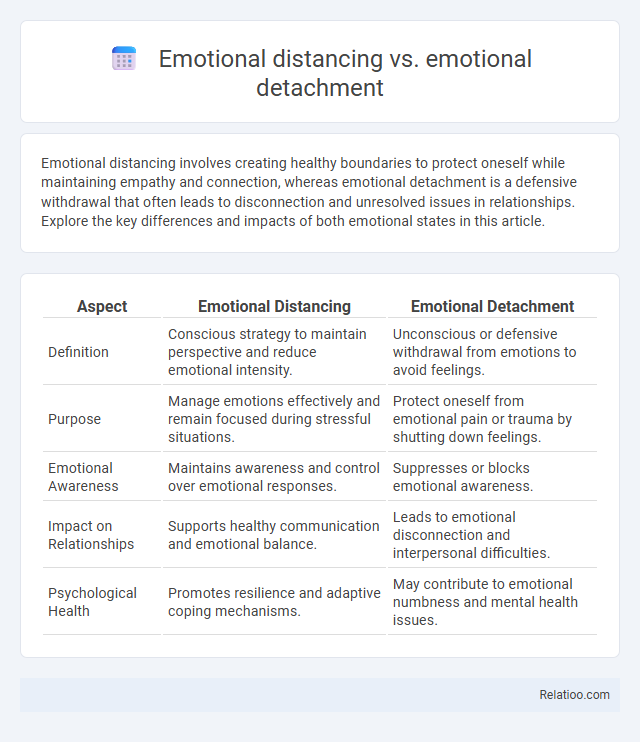Emotional distancing involves creating healthy boundaries to protect oneself while maintaining empathy and connection, whereas emotional detachment is a defensive withdrawal that often leads to disconnection and unresolved issues in relationships. Explore the key differences and impacts of both emotional states in this article.
Table of Comparison
| Aspect | Emotional Distancing | Emotional Detachment |
|---|---|---|
| Definition | Conscious strategy to maintain perspective and reduce emotional intensity. | Unconscious or defensive withdrawal from emotions to avoid feelings. |
| Purpose | Manage emotions effectively and remain focused during stressful situations. | Protect oneself from emotional pain or trauma by shutting down feelings. |
| Emotional Awareness | Maintains awareness and control over emotional responses. | Suppresses or blocks emotional awareness. |
| Impact on Relationships | Supports healthy communication and emotional balance. | Leads to emotional disconnection and interpersonal difficulties. |
| Psychological Health | Promotes resilience and adaptive coping mechanisms. | May contribute to emotional numbness and mental health issues. |
Understanding Emotional Distancing and Emotional Detachment
Emotional distancing refers to a conscious or unconscious effort to create space between oneself and emotional experiences, allowing for temporary protection from stress or hurt without fully cutting off feelings. Emotional detachment involves a deeper disengagement where an individual suppresses or disconnects from emotions, often resulting in reduced empathy or numbness. Understanding these differences is crucial for recognizing how individuals cope with emotional challenges, as emotional distancing can be a healthy coping mechanism, whereas emotional detachment may signal underlying psychological distress or avoidance.
Core Differences Between Distancing and Detachment
Emotional distancing involves creating space from intense feelings to protect your mental well-being, often as a temporary coping mechanism, while emotional detachment refers to a more persistent, enduring disengagement from emotions, sometimes linked to psychological conditions. Distancing allows you to maintain a connection with your emotions but with controlled boundaries, whereas detachment results in a lack of emotional responsiveness or empathy. Understanding these core differences helps you recognize when emotional boundaries serve a healthy purpose versus when emotional disconnection may require attention or intervention.
Signs of Emotional Distancing in Relationships
Signs of emotional distancing in relationships include reduced communication, lack of eye contact, and avoidance of shared activities. Partners may exhibit emotional withdrawal, expressing indifference or detachment from each other's feelings. This behavior contrasts with emotional detachment, which is more pervasive and often involuntary, while emotional distancing tends to be a conscious or situational response.
Indicators of Emotional Detachment in Individuals
Emotional detachment is characterized by a persistent inability to form emotional connections, often leading to a lack of empathy, reduced emotional responsiveness, and withdrawal from personal relationships. Indicators of emotional detachment in individuals include chronic feelings of numbness, difficulty expressing emotions, and a preference for isolation or solitude to avoid emotional engagement. Unlike emotional distancing, which is a temporary and conscious boundary-setting strategy, emotional detachment reflects a deeper, often unconscious defense mechanism that impacts interpersonal functioning.
Psychological Causes Behind Emotional Distancing
Emotional distancing involves creating a psychological buffer to protect oneself from stress or trauma, often rooted in past experiences of hurt or betrayal, whereas emotional detachment reflects a deeper disengagement that can stem from prolonged exposure to emotional neglect or unresolved trauma. Your mind may use emotional distancing as a defense mechanism to reduce vulnerability and manage anxiety in relationships, while emotional detachment might emerge as a chronic response to overwhelming emotional pain or mental health disorders like depression or PTSD. Understanding the psychological causes behind emotional distancing helps in recognizing how past attachment styles, coping strategies, and unresolved emotional conflicts influence interpersonal dynamics and mental well-being.
Root Factors Leading to Emotional Detachment
Emotional detachment often stems from root factors such as prolonged stress, trauma, or unresolved psychological issues that cause individuals to withdraw as a defense mechanism. Unlike emotional distancing, which is a conscious choice to create space for self-preservation, emotional detachment is typically an unconscious response to protect oneself from pain or emotional overload. Chronic neglect, abandonment, and insecure attachment patterns also significantly contribute to the development of emotional detachment, impacting relational dynamics and mental health.
Emotional Impact on Individuals and Loved Ones
Emotional distancing involves creating healthy boundaries to protect your well-being without completely shutting down feelings, which helps maintain connection while reducing stress. Emotional detachment, however, often leads to numbness or disconnection that can harm relationships and cause feelings of isolation for both individuals and their loved ones. Understanding these distinctions is crucial for managing emotional health and preserving meaningful bonds in your life.
Healthy Boundaries vs Harmful Detachment
Emotional distancing involves creating healthy boundaries that protect your well-being without cutting off genuine feelings, fostering balanced relationships and personal growth. Emotional detachment often leads to harmful detachment, where feelings are suppressed or ignored, causing isolation and impaired emotional connections. Understanding the difference helps you maintain healthy boundaries while avoiding the negative effects of emotional numbness and disconnection.
Strategies for Navigating Emotional Distancing
Emotional distancing involves creating healthy boundaries to protect your well-being without completely shutting down feelings, while emotional detachment is often a more severe, involuntary disconnection from emotions. To navigate emotional distancing effectively, practice mindfulness to remain aware of your emotions, communicate openly to maintain connection, and set clear boundaries that support both your needs and relationships. These strategies help you balance emotional involvement and self-preservation, preventing deeper detachment or unresolved emotional strain.
Healing and Reconnecting After Emotional Detachment
Emotional distancing involves creating a temporary space to regulate feelings, whereas emotional detachment represents a more chronic disconnection often linked to unresolved trauma or defense mechanisms. Healing after emotional detachment requires intentional practices such as therapy, mindfulness, and building trust to foster reconnection with oneself and others. Reestablishing emotional intimacy is essential for overcoming detachment and nurturing authentic relationships grounded in vulnerability and empathy.

Infographic: Emotional distancing vs Emotional detachment
 relatioo.com
relatioo.com